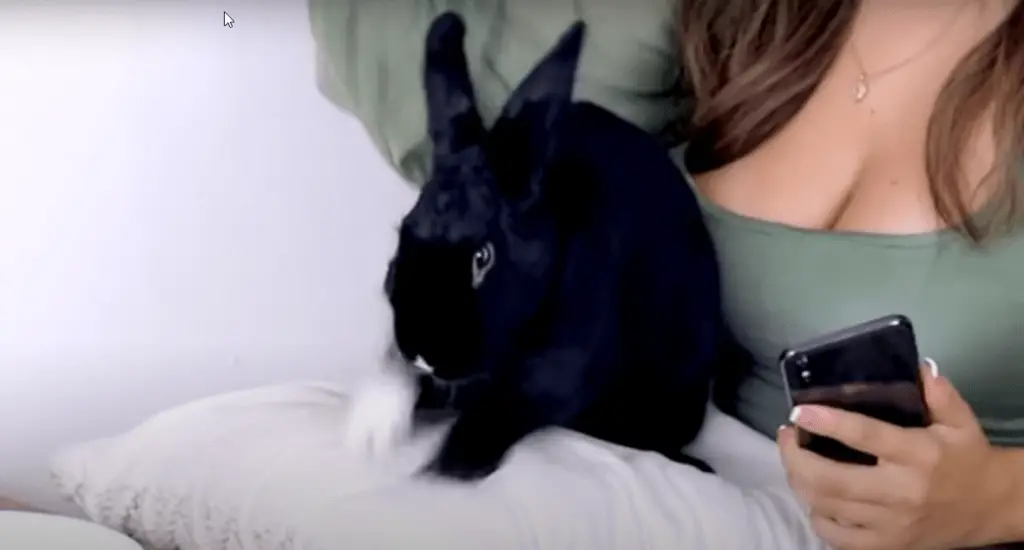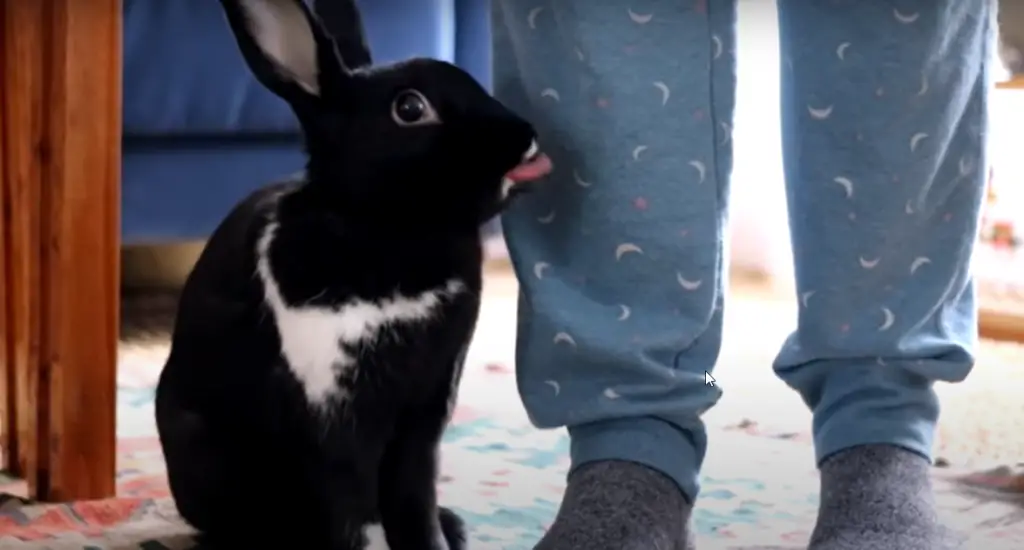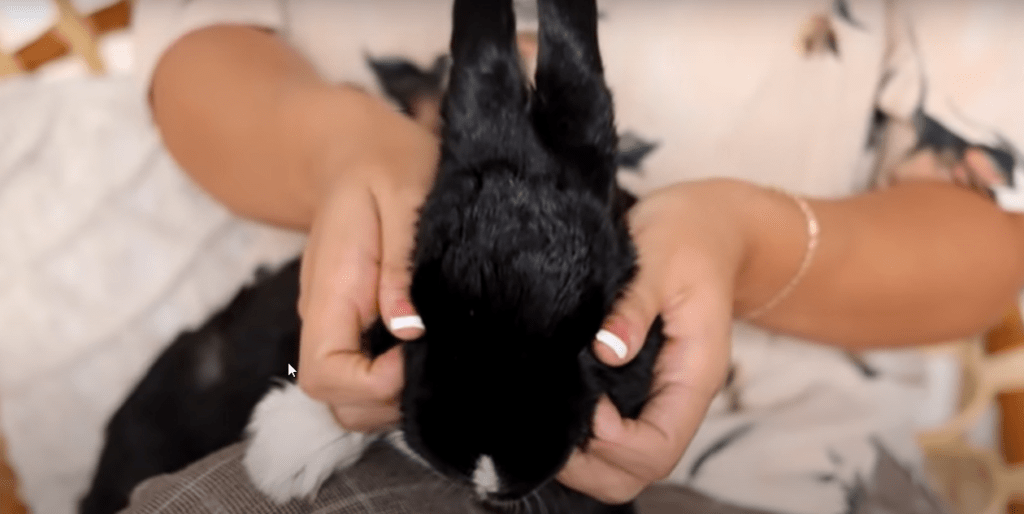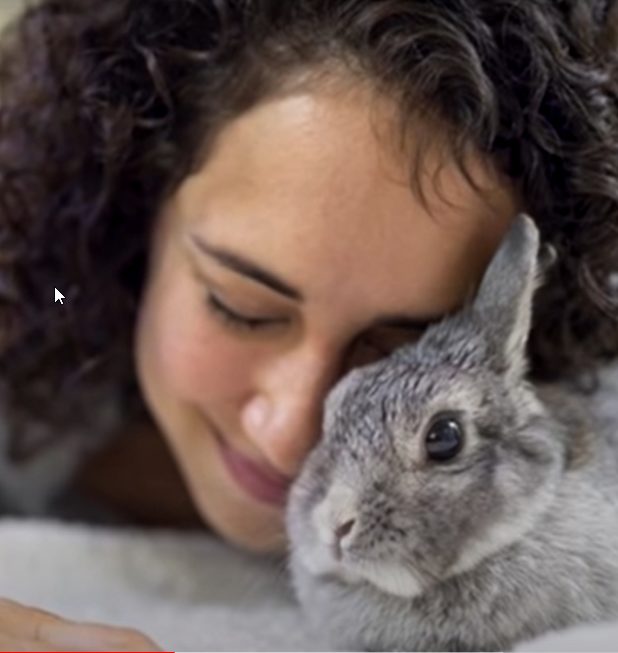Understanding my Rabbit , its behavior and body language
rabbits have many interesting behaviors and body language quirks. What do the different types of behavior, postures and actions of the rabbit mean? Here is a quick guide to some common behaviors you may encounter with your big-eared animal.
Rabbits adopt many behaviors and postures to express their desires and emotional states, to defend their territory, to express anger and joy and many other behaviors that we will see in this article.
The different behaviors of the pet rabbit

1-Jumping or dancing Bunny
Jumping or dancing is a sign of pure joy and happiness. The rabbit “dance” can include jumping, binky (jumping straight and spinning in the air) and running around.
2-Rabbit flop
A flop rabbit is very funny and indicates a happy and/or tired rabbit.
3-Rubbing the chin to mark its territory
Rabbits rub their chin (which contains scent glands) on objects to put their perfume on them. This behavior indicates that the objects belong to them and also marks their territory. The smell is undetectable to humans.
4-Grunts
Why do rabbits growl? when your rabbit grunts, it usually means it’s angry and may feel threatened. Sometimes the growling is followed by a pinch or a bite.
Some rabbits don’t like it when you rearrange their cages while you’re cleaning; they may growl, charge or even pinch you when you try. They are creatures of habit and once things are going well, they like to keep it that way.
5-Striking or stomping
When a rabbit tramples or bumps, it indicates fear, insanity or a sense of danger (real or imagined).
6-Soft or loud teeth grinding noise
Rabbits can gently grind their teeth when they are satisfied (for example, when you pet them). However, noisy teeth grinding may indicate that the rabbit is in pain or is sick. Take your rabbit to a veterinarian if you hear noisy teeth grinding.
7-Rabbit circling around your feet
When a rabbit goes around a person’s feet or legs, this behavior usually indicates sexual or mating behavior (even when your rabbit is neutered). Basically, it means “I love you”.
8-Playing
How do rabbits play? Well, they like to push or throw things. They can also run wild around the house, jump on furniture and act like children who have had too much sugar. Rabbits love toys and some play for hours with a favorite toy.
9-Rabbit bites or stings
Rabbits will sting to get your attention, or to politely ask you to get out of their way. Rabbits don’t usually bite, but if they do, it doesn’t usually mean they hate you.
There are many reasons why a rabbit may bite; for example, it may bite if you catch or surprise it.
A rabbit can also accidentally bite by pulling on your pant leg. Another reason rabbits bite is that they have poor near vision, so they may think that your finger coming at them is food or a predator.
To stop rabbit bites, give an immediate scream when you get bitten.
Rabbits do this when they are injured. Since they usually have no intention of hurting you, they will be surprised that you screamed and will usually stop the behaviour after a few times.
10-Urine spraying
Why do male and female rabbits spray urine? They mark their territory. Unspayed males will mark female rabbits and their territory by spraying them with urine. Unspayed females can also engage in this behavior. This is another good reason to spay or neuter your rabbits.
11-Rabbit marking her territory with feces
Excrement that is not in a heap, but scattered, is a sign that this territory belongs to the rabbit.
This behavior sometimes occurs when a rabbit enters a new environment or when another rabbit is brought into the house. It can be temporary or permanent. Piled feces indicate that the rabbit needs more litter training.
12-Rabbit in distress ; Cry of emotion
This is an indication that your rabbit is injured or dying. Please consult a doctor immediately.
13-False pregnancy in rabbits
Even if a rabbit is not pregnant, an unspayed female rabbit sometimes builds a nest and pulls hair from her chest and belly to align the nest. She may even stop eating – a behavior that usually occurs the day before delivery.
Understand the gestures and Some other different Rabbits comportment

14-Rubs his chin on objects
When he rubs his chin against objects, it is a way for him to mark his territory. They have glands that secrete a substance that is painless for humans but perceptible to another rabbit’s nose. Very curious, he likes to roam and explore the world around him. At home, he will go to conquer every nook and cranny to make it his own.
15-Flattens on the ground
It is a behavior indicating that he is terrorized by something. It is therefore necessary to gently caress him to reassure him. You can also talk to your miniature rabbit at the same time to calm him down. He may flatten on the ground if you come to reprimand him, because he heard an unexpected noise, because another animal scared him, etc…
Cambered, horizontal tail
When the rabbit arches, it expresses a state of tension and stress caused by something from the outside. It is necessary to calm it with caresses and if this state of tension persists, it is better to put it back in its rabbit cage where it will feel protected by its usual environment.
16-Ears lying down and tense body
When his ears are lying down and his body is tense, this behavior of the rabbit indicates aggressiveness and a risk of biting. It is therefore better to be careful how you handle it and be wary of a possible attack. Rabbits are usually not aggressive, so it is best to anticipate an attitude that would lead them to be aggressive.
17-Slaps on the ground with its paws
It is a warning signal that often precedes a leak. It shows you his displeasure (often when he gets into his cage for example). The rabbit may start tapping the floor when you approach it to let you know that it does not want you there, or because it does not want to get into its cage.
18-Raised on its hind legs
This is the classic posture that rabbits adopt when they are “eaten” by curiosity: they stand upright on their hind legs.
19-Lying down, legs relaxed
This means that the rabbit is resting and should not be disturbed. He adopts this posture when he is relaxed and no outside disturbance disturbs him. Rabbits are generally less active in the evening and at night, during which time they generally adopt a relaxed posture.
20-Gives snout strokes
It’s a real invitation to play or cuddle. It is a real invitation to play or cuddle, so take advantage of it to offer him moments of play and strengthen the bonds with your rabbit. Playing is a real need for the rabbit, especially for the youngster who devotes more time to it than adults.
He jumps, climbs everywhere, pushes objects, goes through tunnels, scratches or gnaws… These activities are important for him and can alter his behavior: in fact, the more he plays, the more playful and cheerful he can become.
You can offer him simple toys: a cardboard box for him to jump into, a small plaid that he will move around for fun, etc… Here is a great toy, loved by rabbits: they pull out carrots and play with them.
21-Jumps up and down
Your rabbit expresses its joy and is happy. This is a frequent and brief behavior of rabbits. You should not worry because it shows the good health of your pet, he feels good and just wants to let off some steam.
22-Gnawing on the bars of the cage
He shows that he wants to get out, so it becomes important to let him stretch his legs out of his cage. Contrary to what some people think, the rabbit is not teething.
23-Licks his fur
Rabbits are very clean animals. They clean themselves by first licking themselves or their paws and then rubbing them on the body. When they live in groups, they groom each other (which also helps to strengthen their bonds). Over the course of a day, a rabbit’s toilet is quite frequent, which eventually keeps it busy for a while.
How to train pet rabbits to reduce unwanted behaviors ?
Rabbits, like other pets, are sometimes nasty.
When this happens, remember that you should never hit a rabbit. It is cruel and they don’t understand why they are in trouble.
They can also become very angry and aggressive if provoked. Instead of punishing bad behavior, it is usually much more effective to use positive reinforcement to encourage your rabbit to behave the way you want it to behave.
Always be consistent when disciplining rabbits and don’t expect too much from them. Here are two humane things to try if your rabbit is a little upset :
Shout “no” or clap your hands.
Stomp your foot, like a rabbit, to express your dissatisfaction.
You can help reduce unwanted behaviour in your rabbit by neutering it, getting it out of its cage regularly and providing it with lots of toys so it’s always busy and not bored.
The different reasons that can make a rabbit aggressive
1- The protection of an essential resource for the rabbit:
Its food, for example when you take its bowl of pellets or vegetables to clean and/or refill it,
Its territory, for example when you put your hand in its cage or the shed it is used to shelter in, or when a “foreign” rabbit enters its cage or enclosure,
His females (for a male), for example when another male tries to attack the rabbit that usually spends his time with him, or when this other male tries to take his place in this female’s favourite space,
Its position in the hierarchy (inseparable from the previous elements), for example when a hierarchically inferior rabbit refuses to groom a dominant rabbit, or when your rabbit asks for petting by laying his head down on the ground and you don’t comply.
2- Fear:
Aggression is then a natural defensive behavior that aims at saving the rabbit, for example if it feels seriously endangered by a person or another animal without having the possibility to run away (the rabbit is not necessarily really endangered, but this is its perception of the situation).
3- frustration:
Frustration can lead to secondary aggression: the rabbit, not being able to obtain a resource or situation it wants, then redirects its anger to something else, for example if it cannot escape from a place it finds frightening or if you do not bring it food quickly enough.
Preventing behavioral problems in rabbits

The pet rabbit and the wild rabbit are extremely similar in terms of vital needs and behavior.
If you want your rabbit to be happy and healthy, it is therefore very important to be familiar with the living conditions of its wild cousin (in terms of habitat and social relations) and to take this into account when organizing its living conditions and environment.
Without being able to benefit from a sufficiently rich and interesting environment, to be able to exercise daily and to benefit from your attention and the presence of a rabbit companion (which represents the best company for him), your rabbit risks developing “abnormal” behaviors that express his malaise.
In particular, he may :
- be depressed
- become aggressive
- very frequently gnaw the bars of his cage
- stay curled up in a corner all the time
- hiding all the time
- refuse to come out of his cage or to come to you
- go around in circles in his cage
- Pulling out hair (self-mutilation)
- show excessive eating or grooming behaviours.
There are very simple solutions to prevent the appearance of these behavioral problems and ensure the well-being of your rabbit and your rabbit :
1) Provide your rabbit with a rich, varied and stimulating living environment
By giving it tunnels and sheds in which it can hide, platforms on which it can jump and lie down, as well as lots of toys that it can tear, scratch, push, shake, throw, etc. And to install these different accessories, it is preferable for your rabbit to live in a pen or in freedom, and not in a cage.
2) Provide them with plenty of hiding places
Rabbits are animals of prey. Their natural behavior in the face of potential danger is to run away and hide. Therefore, they feel much safer when they have multiple shelters in which to take refuge.
3) Allow them to stretch their paws every day ” play time “
Leaving them free in a large, safe space with plenty of hiding places and toys to stimulate them (in one or more rooms of the house, in the garden, or in a large outdoor enclosure). Rabbits love to run, dig and jump: they need to be able to express these natural behaviors to stay balanced both physically and emotionally.
4) Allow them to live with another bun
Rabbits are very intelligent and sociable animals that need to be able to communicate, play, cuddle, eat and sleep with other rabbits of their species. Spend some time with your rabbit every day as well. Rabbits can be trained (e.g. clicker training). This education can be a great stimulation for him and an opportunity to enrich and deepen the bond between you.
5) Offer your Rabbit a balanced diet
Consisting of large quantities of hay or grass, fresh greenery and (possibly) some wholegrain pellets.
Be creative in the way you make the food available: use a variety of containers and place them in different places (bales of natural material, cardboard boxes, hay racks/containers of various shapes, pellet dispensing bales, natural candy trees, etc.), so that the search for food becomes a real activity for your rabbit again.
Allowing him to regain this natural behavior will keep him busy and stimulate him greatly.
6) Accept Your Fluffy as he is
A rabbit is neither a dog nor a cat: simply a rabbit with a specific language and needs. And each rabbit has its own personality: that’s what makes it so endearing and irreplaceable.
Rabbits can become truly extraordinary pets as soon as you make the effort to better understand their behavior and respect their special needs.
Let’s wrap this up
Each rabbit has its own character which will result in a unique behavior.
As a parent, you should try to discover your rabbit’s unique traits in order to understand and predict its behavior.
Your rabbit will only behave badly if there is a valid reason for it, and since you have restricted his natural space by keeping him away from his vast meadow, you must also put up with his rare moments of stress and misbehaviour.
Finally, you should know that rabbits never behave badly, but it is just us who interpret their behavior this way, they are animals and it is up to us to understand and tolerate them if we want to live together…



